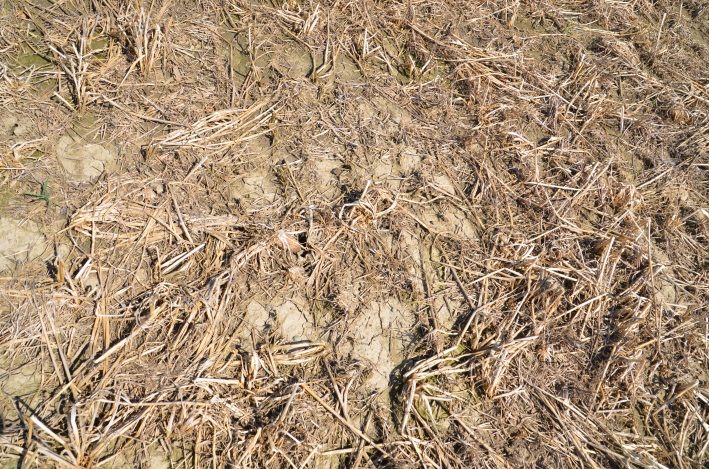This is a good day to reprint some articles about soil cover. This second one is from Adam Hayes, OMAFRA Soil Management Lead for Field Crops. This was originally run in the CropTalk newsletter in 2013.
Protecting the Soil Over Winter
The fall harvest is all but almost complete. The crop has provided cover for the soil through the summer and early fall. Between now and next spring’s planting when the crop is planted again, the soil will be exposed to pounding rains, overland flow from rain and melting snow, and high winds. All of these can cause significant soil loss and from fields or at the very least strip productive soil from areas within the fields. That soil is lost and the productivity of those areas reduced. A few simple measures can go a long way to protecting your soil.
50% Residue Cover
One of the easiest things to do is to leave at least 50% of the soil surface covered with crop residues in the fall. A minimum of 50% cover of corn and cereal residue (Figure 1) will protect the soil in most situations. Lighter residues such as those from soybeans and edible beans, generally require a higher per cent residue cover to provide adequate soil protection. To achieve this goal, do as little tillage as possible where residues have not been spread evenly. It goes without saying that leaving all crop residues on the soil surface will provide the most protection (Figure 2).


If there are areas of the field where concentrated overland flow erodes the soil every year, consider installing an erosion control structure. Assistance in the form of expertise and grants is available from many local conservation authorities and some funding programs.
Fall and Spring Management of Cover Crops
Cover crops are another practice that can help keep the soil covered over winter if managed properly. By early November, many annual cover crops will have been killed by frost, mowed, tilled, or had an herbicide applied. Radish and oats may not be killed by cold temperatures until mid-winter and annual ryegrass and clover will usually survive the winter.
A living winter cereal cover crop can provide good soil protection over the winter, especially on lighter soils. Consider terminating cover crops now that will be alive in the spring and difficult to control in the following crop. This includes if the cover crop is a perennial (clover, annual ryegrass), winter annual, or something that will be alive in the spring (volunteer winter wheat). Consider terminating it now, especially if it may be difficult to control in the following crop.
Once the cover crop has been terminated, and if the growth is not too thick and tall (Figure 3) it can be left until the following spring and no-tilled into or worked lightly. Many of these cover crops have high water contents or are immature at termination, which means that they will desiccate and melt away to leave very little residue (Figure 4). If the cover crop growth is significant, some fall tillage may be warranted, especially on finer textured soils.

The goal is to keep the soil covered to prevent or minimize soil erosion. Manage crop residues and cover crops to provide that protection.


0 comments on “Keeping the soil covered: managing crop residues and cover crops”